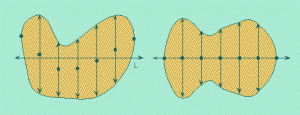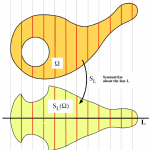SELECTED PUBLICATIONS IN THE HISTORY OF MANIFOLDS WITH DENSITY:
[1959] A. J. Stam, Some inequalities satisfied by the quantities of information of Fisher and Shannon, Indo. Control 2 (1959), 101-112, Eqn. 2.3. Gives a version of Gaussian log-Sobolev inequality, used by Perelman, often attributed to Gross [1975] or sometimes Federbush [1969].
[1966] E. Nelson, A quartic interaction in two dimensions, mathematical Theory of Elementary Particles (Goodman, R. and Segal, I., eds.), MIT Press, 1966, 69-73. Gross [G] says that the entire subject of logarithmic Sobolev inequalities and contractivity properties of semigroups was started in this paper.
[1966] Harper, L. H. Optimal numberings and isoperimetric problems on graphs. J. Combinatorial Theory 1 1966 385-393. Apparently uses measure and metric, cited by Ledoux-Talagrand [1991], both cited by [Ros, §1.4, p. 182].
[1969] Paul Federbush, A partially alternate derivation of a result of Nelson, J. Math. Phys. 10 (1969), 50-52. Gives Gaussian log-Sobolev inequality, used by Perelman, often attributed to Gross [1975], actually probably due to Stam [1959].
[1970] André Lichnerowicz, Variétés riemanniennes a tenseur C non négatif, C. R. Acad. Sci. Paris Sér. A-B 271 (1970), A650-A653. Studies Ric – Hess log density to prove splitting theorems.
[1973] E Nelson, The free Markov field, J. Funct. Analy. 12, 211-227. Gross survey ([G] below) says equivalent form of Gaussian log-Sobolev inequality.
[1975] Christer Borell, The Brunn-Minkowski inequality in Gauss Space, Invent. Math. 30 (1975) 207-216. Also: V. N. Sudakov and B. S. Tsirel’son, Extremal properties of half-spaces for spherically invariant measures, J. Soviet Math. (1978), 9-18 (1974 in Russian). Proof of Gaussian isoperimetric inequality.
[1975] Gross, Leonard, Logarithmic Sobolev inequalities. Amer. J. Math. 97 (1975), no. 4, 1061-1083. Proves Gaussian log-Sobolev inequality, used by Perelman. Not yet realized that it was trivial consequence of Gaussian isoperimetric inequality via analytic version which [Ros, §3.4] traces back to Ehrhard [E, 1984] and Bobkov [B7, 1997], first observed by Ledoux ’94 and Beckner ’96 (published [1999]) (see Morgan Blog and email from Milman). Precursors are Stam [1959] and Federbush [1969] (see Gross survey [G]). Continue reading ‘Manifolds with Density: Fuller References’ »



 Welcome to my blog. I also have a blog at the
Welcome to my blog. I also have a blog at the